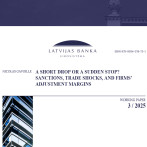Trade pulse remains stable
Retail trade continues to demonstrate a stable rhythm of change: as of the very beginning of the year, it has gone up, then down, up again, down again. The data for July published today retain this rhythm of fluctuation and, after a drop in June, we once again witness a rise: the retail turnover has grown by 2.1% (month-on-month, seasonally adjusted data at constant prices). Year-on-year, trade has grown 5.5%.
The month-on-month fluctuations are unavoidable because of the relatively small volumes of consumption; moreover, trade tends to be influenced by additional factors. This time, I would like to expand on one of the most topical processes impacting trade.
July is one of the most active months of the tourist season. Albeit the visits of foreign guests are of a pronouncedly seasonal character, their intensity can differ from year to year. Last year, tourism grew at a moderate rate, whereas this year, we see a more substantial rise in the number of tourists.
In the second quarter, the number of guests served in hotels increased 10.5% year-on-year. It was primarily the number of foreign tourists that grew: they account for more than two thirds of the persons served and their number grew by 12.3%, whereas the number of Latvian travellers increased at a more moderate rate, by 6.5%. The occupancy rate of hotels has also risen substantially, lagging behind only that of 2005, when, after joining the European Union, the interest of tourists grew rapidly and the supply of hotel rooms was 50% less than now.
In July-August, the activity of tourists has definitely not gone down, as we could observe daily in the places favoured by tourists: the Old Town of Riga, Jūrmala, Sigulda and elsewhere. It is indisputable that tourists impact trade: that is evidenced both by these trade data and their structure as well as other information. For instance, the turnover in the "tax-free" zones has been posting a very rapid rise in recent years, keeping pace with the substantial rise in the number of tourists from Russia and other CIS countries.
The expenditures of foreign guests have the most impact on the hotel and catering as well as transport branches, thus promoting a rise in gross value added and exports. Retail turnover is mostly determined by the expenditures of the population: foodstuffs account for about 40% of sales volumes. Tourist purchases form a relatively small part of the turnover, at the same time providing better opportunities for profit to the sellers and producers of various kinds of souvenirs, jewellery, furniture, wearing apparel and accessories, often ensuring the bulk of annual income for these enterprises. Thus tourism is an important factor in the development of this branch.
Textual error
«… …»






